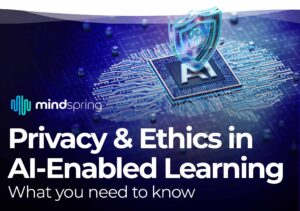Organizations offer training to their employees for many reasons, but ultimately, the value of training always comes back to the bottom line: workers that are more effective, more motivated, and more skilled. However, just because learning initiatives ultimately benefit the organization doesn’t mean they shouldn’t–and don’t–also provide enormous value to participants. By creating training that is learner-centric, everyone gets more value out of learning, creating the ultimate business win-win. But what does learner-centric training look like? Here are a few things to think about:
Make Use of Personalization
The most direct way to show learners that you value them is making learning more personal. Personalization has been sweeping the business world, from marketing to sales to customer service, so it’s only natural that personalization be applied to internal processes like learning, and to great effect. Today’s design and customization tools make it easy to personalize a learning module with the participant’s name, occupation, and more, and even a little nod can help your employees feel more connected with the training.
Be Cognizant of Their Time
Unless you offer paid training, most of your employees probably don’t have vast stretches of time to spend learning your organization’s material; and even if you do, ongoing learning is always made harder by regular work responsibilities and personal lives. The solution? Get to know your participants. That way, you can design the content and delivery to suit their needs and busy schedules. For example, shorter lessons and more frequent knowledge checks could help on-the-go workers learn more effectively, and the ability to access materials online allows remote workers to come back to the training at a time that works for them.
If you’re using instructor-led training (ILT) as part of your learning strategy, make the most of everyone’s time by skipping the lecture-style method of delivery. Blended learning allows participants to learn baseline information in an online learning module, then discuss the new knowledge face-to-face with their peers and instructors. This helps reinforce the new information for better understanding and retention.
Celebrate Their Effort
Participating in learning initiatives isn’t necessarily most people’s favorite part of their job, and that’s okay. However, for learning to be effective, participants have to be open to it. One good way is to acknowledge, and further, celebrate the time and effort that participants put into training. Create a community where people can discuss new information and share their favorite moments, especially if some of the learning is taking place at an event.
In addition, there are some people for whom learning really does get them excited. These people, your champions, are valuable resources to your learning initiatives. They can help get their peers motivated, offer constructive feedback, and help to benchmark excellent performance for future participants. Celebrate their efforts by getting them involved in the planning and execution of learning initiatives. This not only lets them know that you appreciate their efforts, but also helps your organization improve in the long run.
Give Quality Feedback
Knowing if an answer is right or wrong is only the first step to learning the information; knowing why it’s right or wrong is the meat of learning. If your eLearning module returns generic responses to knowledge checks and quizzes, it’s not doing as much as it could be to help participants learn effectively. Instead, design feedback to address why a wrong answer might have been chosen, what the right answer is, and why it’s correct. That way, participants don’t have to go digging, or worse, stop caring.
In terms of ILT and blended training, giving quality feedback requires a little more effort, but it’s perhaps even more necessary. One of the most beneficial parts of including instructors in your learning initiatives is the person-to-person interaction that occurs, so make the most of it by limiting group sizes and setting aside time for specific feedback.
Listen To–and Act On–Evaluations
Collecting evaluations about the experiences of learning module participants is a great way to improve your efforts, but only if you listen carefully and follow through with improvements. Ask for evaluations throughout the training by asking one or two questions after key points, then ask more open-ended questions when they’ve had a chance to gather their thoughts. If people know that their feedback is valued and that their opinion has the potential to create change, they’re more likely to be honest and constructive. Try following up with participants who have made suggestions, and be sure not to take criticism to heart. An improved program helps the entire organization down the line.
Learner-centric training is a different approach than has been used in the past, when ROI was king, but ironically, it has a much bigger payoff. By implementing some of these learner-centric ideas in your initiatives, you can send the message to your employees that you care about more than your bottom line while indirectly giving it a boost.









